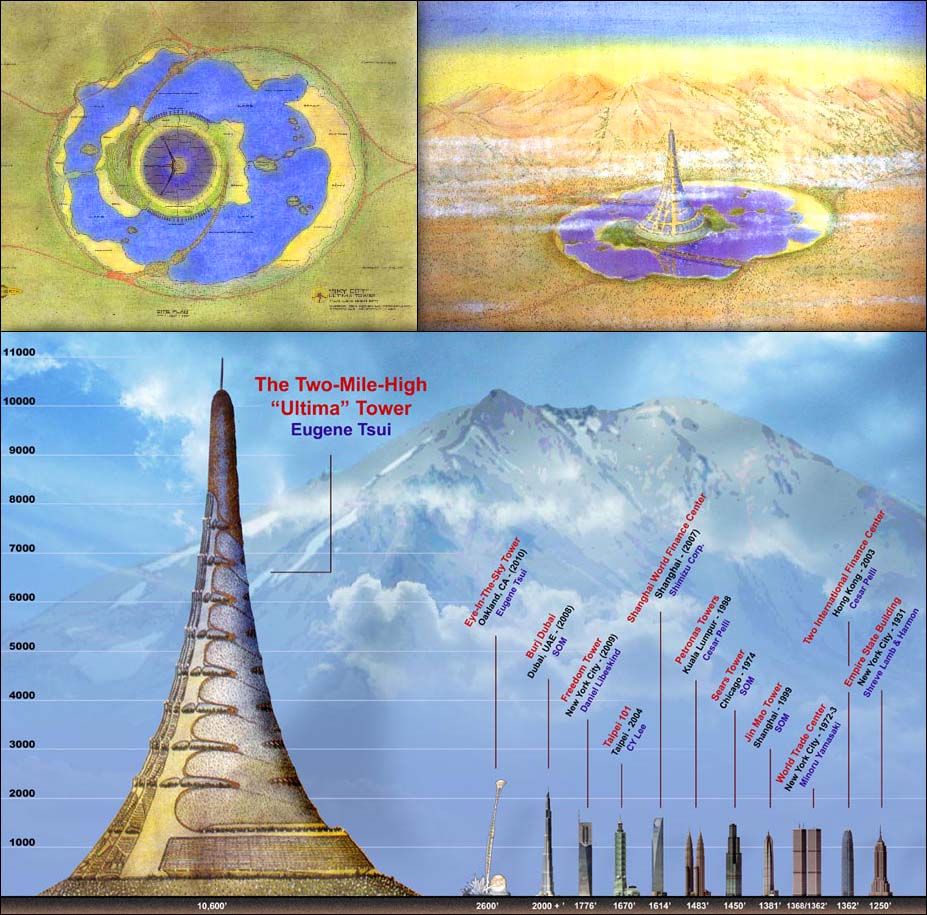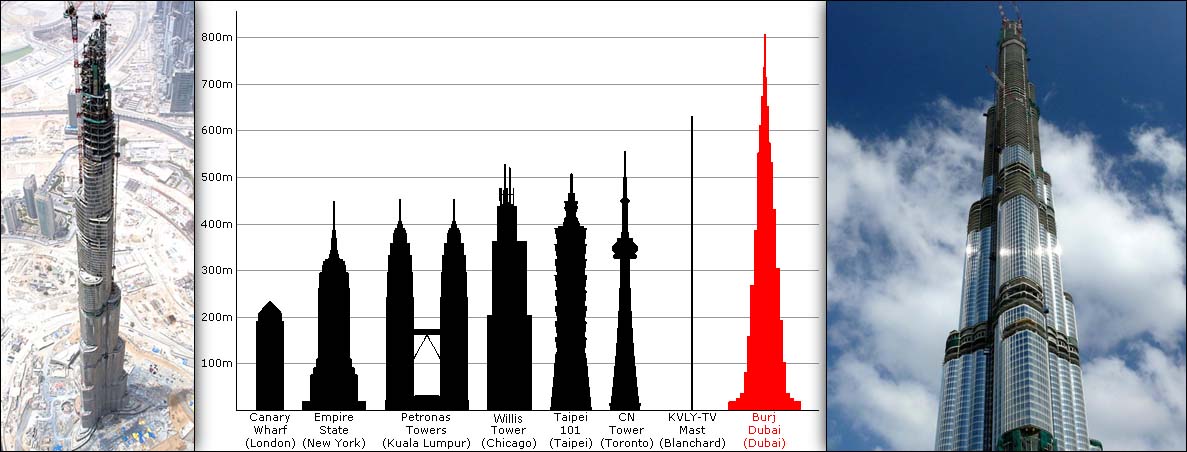Rumble Pie #14
The History of Height
IN OUR BLOG POST of a couple of weeks ago, Beautiful Blanc Walls, we looked at the possibility of greenifying not only the land that surrounds a building, and not even just the land that's on top of a building, but land that's on the sides of buildings, as well! In our blog post of last week, Chow Towers of Babel, we took a close and critical look at the way that our civilization produces most of its human food, far away from most of its humans, and far from healthy for human, animal, and plant alike. Now here in this blog post, The History of High, we will begin examining the futurist pancake-stack answer to the agricultural crisis, Vertical Farming.
PANCAKE-STACKING, the visual metaphor I'm going to use to describe the proposal that human sleeping quarters and work camps be located extremely close to one another, to achieve certain excellent efficiencies of scale, is a state of affairs that is completely alien to the way that humans have lived on the planet for 99% of the time that they have been classified as distinctly human, of the species homo sapiens sapiens. But in the last hundred years, humans have started to imagine a not-too-distant future where they live less like monkeys and more like termites or bumblebees.
 IN 1908, AMERICANA ARTIST William Robinson Leigh produced a painting entitled Visionary City. In it, he imagines an urban area of such complexity and compactness that it surpasses even contemporary rates of human density. Look at this image in isolation and it seems that Leigh is glorifying twenty-first century technae. But compare it to the rest of his large body of work -- which consists almost exclusively of idealized desert landscapes and indigenous peoples of the Southwest -- and it is instantly transformed into a dystopia. Observe the human subjects that Leigh lovingly portrays: they are obviously affluent, they have all the time in the world to embellish their own artwork or just stare off into the sunset.
IN 1908, AMERICANA ARTIST William Robinson Leigh produced a painting entitled Visionary City. In it, he imagines an urban area of such complexity and compactness that it surpasses even contemporary rates of human density. Look at this image in isolation and it seems that Leigh is glorifying twenty-first century technae. But compare it to the rest of his large body of work -- which consists almost exclusively of idealized desert landscapes and indigenous peoples of the Southwest -- and it is instantly transformed into a dystopia. Observe the human subjects that Leigh lovingly portrays: they are obviously affluent, they have all the time in the world to embellish their own artwork or just stare off into the sunset.

 ARCOLOGY IS THE WORD that has been used ever since his time to describe an environment that is composed primarily of architectural elements. Only for the last forty years has the term been used by Italian-American architect Paolo Soleri to signify environmentally conscious architecture -- specifically, the purposeful densification of human habitation, not only for logistic reasons in order to achieve greater rates of economic production, but for ecologic reasons in order to mitigate the devastating destructive impacts of human economic activity to the planet and her playthings.
ARCOLOGY IS THE WORD that has been used ever since his time to describe an environment that is composed primarily of architectural elements. Only for the last forty years has the term been used by Italian-American architect Paolo Soleri to signify environmentally conscious architecture -- specifically, the purposeful densification of human habitation, not only for logistic reasons in order to achieve greater rates of economic production, but for ecologic reasons in order to mitigate the devastating destructive impacts of human economic activity to the planet and her playthings.
STARTING IN THE LATE 1960's, Soleri began to react to suburban sprawl by designing arcologies of up to a million human residents. By dispensing with private automobiles altogether, Soleri prefigured that pedestrian culture would be paramount, that all interpersonal interactions would occur at a much more human scale. The land surrounding the megalopoli would be reserved for recreation, and further afield, for farming. Architecture and agriculture were still separate components in Soleri's system, but his hyperbuildings would enter the public consciousness. Since the 70's, he has built the beginnings of Arcosanti, an intentional community in the Arizona desert based on his planning principles.
 MANY FANTASTIC ARCOLOGIES have been brainstormed since then. I believe that the most fantastical of these is the Bay Area Architect Eugene Tsui's Ultima Tower. At two miles high, it dwarfs all existing skyscrapers by more than a factor of five! In 2004, I apprenticed at his Oakland offices and had the chance to work on some of his amazing projects. Eugene is a biomimic, so he looks at animal architecture and draws inspiration from their ingenius building techniques. If humans are going to end up living like insects, in infinite condominiums, then it would make good sense for our human hives to resemble massive African anthills, and that's what the Ultima Tower appears to be.
MANY FANTASTIC ARCOLOGIES have been brainstormed since then. I believe that the most fantastical of these is the Bay Area Architect Eugene Tsui's Ultima Tower. At two miles high, it dwarfs all existing skyscrapers by more than a factor of five! In 2004, I apprenticed at his Oakland offices and had the chance to work on some of his amazing projects. Eugene is a biomimic, so he looks at animal architecture and draws inspiration from their ingenius building techniques. If humans are going to end up living like insects, in infinite condominiums, then it would make good sense for our human hives to resemble massive African anthills, and that's what the Ultima Tower appears to be.
 BUT MOST EGOTISTICAL ARCHITECTS don't look to nature as a model master-builder, but as an adversary to be conquered and controlled. So as the planetary population skyrockets and rural residents follow the jobs to the big cities, engineers everywhere are drafting up plans to shoot up to increasingly absurd heights. It is almost impossible to see this pattern as anything other than cock-jockeying, an architectural attempt to prove that you have a sizable phallus. That, and the ideological extension of the colonial project to the in-between spaces in a world in which there are no more physical frontiers.
BUT MOST EGOTISTICAL ARCHITECTS don't look to nature as a model master-builder, but as an adversary to be conquered and controlled. So as the planetary population skyrockets and rural residents follow the jobs to the big cities, engineers everywhere are drafting up plans to shoot up to increasingly absurd heights. It is almost impossible to see this pattern as anything other than cock-jockeying, an architectural attempt to prove that you have a sizable phallus. That, and the ideological extension of the colonial project to the in-between spaces in a world in which there are no more physical frontiers.
 BUT NOW IN THE NEW MILLENNIUM, since the granaries of the West aren't growing quick enough to keep up with more than seven billion bellies, at long last, ecological sustainability is starting to take to the stage. Architectural firms are beginning to take plant elements much more seriously in their skyscraper designs. Unfortunately, some of these examples are only green window dressing, like putting on lots of perfume when you haven't bathed your body recently enough. But some forward-thinking people are proposing a radical idea -- turning big buildings into fifty-story full-on farms, to feed the people.
BUT NOW IN THE NEW MILLENNIUM, since the granaries of the West aren't growing quick enough to keep up with more than seven billion bellies, at long last, ecological sustainability is starting to take to the stage. Architectural firms are beginning to take plant elements much more seriously in their skyscraper designs. Unfortunately, some of these examples are only green window dressing, like putting on lots of perfume when you haven't bathed your body recently enough. But some forward-thinking people are proposing a radical idea -- turning big buildings into fifty-story full-on farms, to feed the people.
IS THE PANCAKE-STACK PLANTATION even possible? If so, is it desirable? Will it fix our plethora of problems? Or will it cause even more of them? Can cubicles co-exist with tractors? Or is this complicated scheme just another bluff by the industrial capitalist system? In our next blog, Grasping at Grass, we focus our sights on Vertical Farms, architecture's answer to edible jenga.
|

